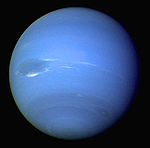- Halimede (moon)
-
Halimede 
Discovery [1][2] Discovered by - M.Holman
- JJ Kavelaars
- T. Grav, W. Fraser
- D. Milisavljevic
Discovered August 14, 2002 Mean Orbital elements [3] Epoch June 10, 2003 Semi-major axis 16.611 Gm Eccentricity 0.2646 Inclination 112.712° * Orbital period 1879.08 d
(5.14 a)Physical characteristics Mean diameter 62 km[4] ** Rotation period ? Albedo 0.04 assumed[4] Color neutral (grey)
B-V=0.73 R-V=0.35[5]Spectral type ? *to the ecliptic **based on the albedo Halimede (
 /ˈhælɨˈmiːdiː/ hal-i-mee-dee; Greek: Αλιμήδη) is a retrograde irregular satellite of Neptune. It was discovered by Matthew J. Holman et al. on August 14, 2002.[6]
/ˈhælɨˈmiːdiː/ hal-i-mee-dee; Greek: Αλιμήδη) is a retrograde irregular satellite of Neptune. It was discovered by Matthew J. Holman et al. on August 14, 2002.[6]Halimede has the second most eccentric and third most inclined orbit around Neptune.[7] This is illustrated on the diagram in relation to other irregular satellites of Neptune. The satellites above the horizontal axis are prograde, the satellites beneath it are retrograde. The yellow segments extend from the pericentre to the apocentre, showing the eccentricity.
Halimede is about 62 kilometers in diameter (assuming an albedo of 0.04)[4] and appears neutral (grey) in the visible light. Given the very similar colour of the satellite to that of Nereid together with the high probability (41%[6]) of collision in the past lifespan of the Solar System, it has been suggested that the satellite could be a fragment of Nereid.[5]
Halimede, or Neptune IX, like many of the outer satellites of Neptune, is named after one of the Nereids, the fifty daughters of Nereus and Doris. Before the announcement of its name on February 3, 2007 (IAUC 8802), Halimede was known by the provisional designation S/2002 N 1.
References
- ^ JPL (2011-07-21). "Planetary Satellite Discovery Circumstances". Jet Propulsion Laboratory. http://ssd.jpl.nasa.gov/?sat_discovery. Retrieved 2011-10-24.
- ^ Green, Daniel W. E. (January 13, 2003). "Satellites of Neptune". IAU Circular 8047. http://www.cbat.eps.harvard.edu/iauc/08000/08047.html. Retrieved 2011-10-24.
- ^ Jacobson, R. A. (2008). "NEP078 – JPL satellite ephemeris". Planetary Satellite Mean Orbital Parameters. http://ssd.jpl.nasa.gov/?sat_elem. Retrieved 2009-09-23.
- ^ a b c Sheppard, Scott S.; Jewitt, David C.; Kleyna, Jan (2006). "A Survey for "Normal" Irregular Satellites around Neptune: Limits to Completeness". The Astronomical Journal 132: 171–176. arXiv:astro-ph/0604552. Bibcode 2006AJ....132..171S. doi:10.1086/504799.
- ^ a b Grav, Tommy; Holman, Matthew J.; Fraser, Wesley C. (2004-09-20). "Photometry of Irregular Satellites of Uranus and Neptune". The Astrophysical Journal 613 (1): L77–L80. arXiv:astro-ph/0405605. Bibcode 2004ApJ...613L..77G. doi:10.1086/424997.
- ^ a b Holman, M. J.; Kavelaars, J. J.; Grav, T. et al. (2004). "Discovery of five irregular moons of Neptune" (PDF). Nature 430 (7002): 865–867. Bibcode 2004Natur.430..865H. doi:10.1038/nature02832. PMID 15318214. https://www.cfa.harvard.edu/~mholman/nature_final.pdf. Retrieved 2011-10-24.
- ^ Williams, Dr. David R. (2008-01-22). "Neptunian Satellite Fact Sheet". NASA (National Space Science Data Center). http://nssdc.gsfc.nasa.gov/planetary/factsheet/neptuniansatfact.html. Retrieved 2011-11-03.
- MPC: Natural Satellites Ephemeris Service
- Mean orbital parameters from JPL
External links
- Matthew Holman's Neptune's page
- David Jewitt's pages
- Neptune's Known Satellites (by Scott S. Sheppard)
Moons of Neptune Generally listed in increasing distance from NeptuneRegular (inner) Triton Irregular See also Neptune Discovery 
Characteristics - Rings
- Great Dark Spot
- Small Dark Spot
- The Scooter
- Kuiper belt
Moons Exploration Trojans Miscellaneous Categories:- Moons of Neptune
- Irregular satellites
Wikimedia Foundation. 2010.

